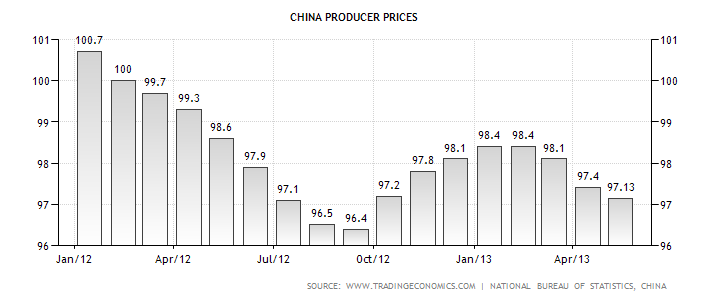China’s consumer price data for June rose thanks to higher food prices mostly, but the real story was in another fall in Producer Price Index which measures price pressures in industry and business.
That fall of 2.7% year on year, from a 2.9% annual rate in May, tells us that the Chinese economy is experiencing weak levels of demand across the board with very little pricing power for companies of all sizes.
As in Australia and most other countries, the rise in China’s Consumer Price Index attracts the most attention from the media and analysts. Last month it rose 0.6% from May (which in turn saw prices dip 0.3% from April), thanks to food prices which were up sharply in the month.
On an annual basis the CPI rose 2.7% from 2.1% in May. thanks to a 4.9% rise in food prices in the month from May. High pork prices and rents were the major influence.
But there was no relief for business as producer prices fell (the prices that businesses charge each other up the levels of production – from raw materials, to intermediate or partly processed goods and to the final stage of a finished good, before it is sold to business or into the distribution or retailing supply chains.
The fall of 2.7% in June was the 16th monthly fall in a row. That confirms the economy’s underlying weakness. Producer prices fell 0.6% from May.
China 1Y Producer Prices – Faltering Demand

Falling commodity prices – copper, iron ore, coal, lead, zinc, etc – contributed to the weakness.
Continuing over-production of a wide range of goods, from steel to cement and aluminium products, is forcing companies to cut costs and try and remain competitive. There is no scope to pass on higher prices for inputs such as oil and gas, which rose in June.
For the first six months of 2013, Chinese consumer price inflation averaged 2.4% (about where Australia’s inflation rate sits) which is well under the government’s target of 3.5%.
Core inflation, stripped of volatile food and energy prices, remained steady at a annual rate of 1.7% in June, further confirming the absence of any inflationary pressures whatsoever in the Chinese economy.
Late today we will get the June trade data. That will start fleshing out the second quarter performance of the economy. The Producer Price data tells us that the weak demand is affecting both domestic and export sectors.
Second quarter data is due out on July 15. First quarter GDP rose 7.7% in the first quarter after a 7.9% rise in the December quarter and 7.8% for 2012 as a whole.
Citigroup yesterday cut its estimate of China’s GDP growth this year from the previous 7.6% to 7.4% and the 2014 estimate to 7.1% from 7.3%.













